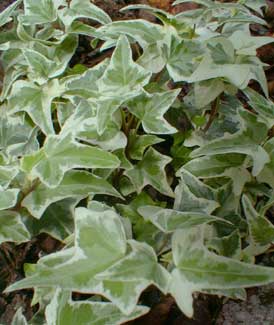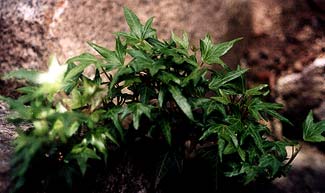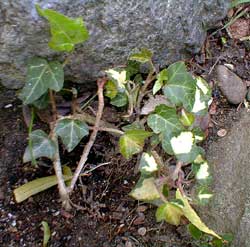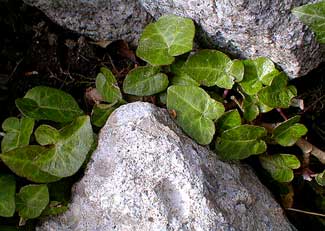
English Ivy,
invasive Hedera helix
vs its non-invasive cultivars
"Lay thick upon the bed on which I lay,
Where through the lattice ivy-shadows crept."
-Christina Rosetti
1830-1894
1830-1894
When we bought our house, an enormous area of ground was densely covered with English Ivy (Hedera helix) as a big-leafed evergreen groundcover that had pretty much choked out anything else that had ever been growing at that end of the yard. Our first year here I often thought of digging it out so as to establish a more elaborate garden along that space of ground. But the task seemed so overwhelming I kept putting it off.
The second year we owned the place, I was working out in the yard when a young hobo came by & asked across the fence if I had any garden work he could do. Something about him struck me as pleasant even though his current straits were unfortunate. So I gave him a shovel & a pick axe & he spent the next few days doing yardwork, including getting rid of the ivy for me.
 We worked together on other yard projects the following week, & during idle conversations I learned he'd been in a motor cycle accident, gotten pretty well beaned on the noodle, & not been as capable of taking care of himself as formerly, thereby finding himself on a more or less permanent camp-out. He was a good worker but I couldn't afford to pay much so I was glad to lose him when he landed a job helping out a professional landscaper.
We worked together on other yard projects the following week, & during idle conversations I learned he'd been in a motor cycle accident, gotten pretty well beaned on the noodle, & not been as capable of taking care of himself as formerly, thereby finding himself on a more or less permanent camp-out. He was a good worker but I couldn't afford to pay much so I was glad to lose him when he landed a job helping out a professional landscaper.Of the piles & piles of ivy that got rooted up to discard, all I kept of it were a couple decorative roots big around as Popeye's arms. In months & seasons to follow, that whole area was slowly transformed into an elaborate garden for sun-loving plants on the front garden edge, fading to shade-lovers under an old Japanese maple.
It was quite some while before I could stand the idea of planting H. helix because it is notoriously aggressive & I felt so lucky to be rid of what had come with the house. My emotions kept feeling that it would be foolish to replant more. But rationally, the right ivy in the right place oughtn't be a hazard, & I kept pondering it for a dark dry ledge under a douglas fir.
The American Ivy Society had been taking some grief from the public for encouraging ivy usage, which in some regions (including here in the Northwest) has escaped into woodland areas displacing native flora. Even where not invading the wild, it has been so over-utilized that Northwest landscapers are being discouraged from using it. Portland, Oregon, was considering actually outlawing it. Instead of making it illegal, however, increasing numbers of professional landscapers have voluntarily "taken the oath" by voluntarily signing the No Ivy Pledge.
So what's the Ivy Society to do when it is in love with & wishes to promote something that other activists are demanding landscapers cease to use, & asking homeowners to dig theirs out? On the cusp of the new millenium, the American Ivy Society began a campaign to promote non-invasive ivy cultivars. They now annually select a "Non-Invasive Ivy of the Year."
Many people misunderstand what it means to be an invasive ivy. Ivy is actually easy to control if you bother to control it; it's not going to creep rapidly into your yard & be hell to get rid of every year. Ivy's invasive propensity is due to its seeds. Many cultivars of ivys don't flower or seed ever; even the most aggressive wildest forms commonly remain in their juvenile vining stage & do not flower or seed well, especially if growing in shade. The vines can be aggressive if never pruned, but no worse than many another neglectable plant.
They tend to flower only in bright sun, & the vine must first undergo a literal genetic transformation to create upright bush-like bits that are no longer vining. The genetically changed bits are sometimes taken as cuttings & grafted to regular roots, & sold as Tree Ivy because once they have undergone the maturity-change, they can never revert to vines. The form called 'Arborescens' produces flowers & fruits like mad & should not be planted anywhere where ivy is potentially invasive to surrounding woodlands, but other forms do not bare fruit so make safe non-vining ivy-shrubs, usually sold as 'Erecta' 'Congesta' or 'Conglomerata.'
The flowers on a matured/genetically changed ivy turn to berries, birds eat the berries, poop the seeds in the woods, hence the invasiveness. Controlled ivy vines which are kept from fruiting are never invasive in the legal or environmental sense, though they can even so be annoyingly aggressive within the garden.
But exceedingly few fancy cultivated forms are on any list as at all apt to seed into the environment, & even if your neighbor has the aggressive wild form, unless you actually see it flowering & fruiting, it's not actively invasive. If it does seed & is a potential menace, it would be responsible to uproot & discard the ivy, then replace it with a more ornate ivy cultivar that will not seed into the woodlands & parks.
The general rule for assessing ivy cultivars is "the smaller & more variegated or the more deeply cut & delicate the leaves, the less invasive it will be." There are going-on-500 named cultivars of H. helix & the majority (especially those developed in the last 15 years) are extremely strong in the garden but not invasive. It is some of the oldest cultivars & the large leather-leaf plain green English Ivy that is the worst, but its smaller more colorful varieties are by & large safe.
The really bad ones locally are H. hibernica 'Hibernica' which accounts for 80% of the ivies that have invaded woodland areas, with H. helix 'Baltica,' H. helix 'Pittsburgh' & H. helix 'Star' making up the majority of the rest. Those are the only ones listed as Washington state's "Class C invasives" which isn't as nasty as invasives get, but bad enough to require advisory warnings. These have invaded many forested areas & caused considerable harm, sometimes completely eradicating the natural forest's undergrowth, & it is not less damaging in landscape use, killing off all the shorter plants by smothering them, & starving even larger plants for nutrients & moisture.
 Miniature H. helix cultivars & especially those with white or yellow in the leaves, or frilly leaves, or deeply cut almost cannabis-like leaves, are non-invasive. There is some potential for escape but none of the mini-leaf cultivars are on government lists of invasive ivys. 'Jubilee,' 'Buttercup,' 'Spetchley,' 'Goldheart' (shown third on this page), 'Golden Starlight,' 'Golden Curl,' 'Glacier,' 'Willie,' 'Itsy Bitsy,' 'Ingrid' (shown in an October 2005 picture at the top of this page), 'Walthamensis' & many suchlike are safely used English Ivy cultivars. The American Ivy Society's "non-invasive Ivy of the Year" choices included for the first three years of the award 'Lady Francis,' 'Teardrop' & 'Golden Ingot.'
Miniature H. helix cultivars & especially those with white or yellow in the leaves, or frilly leaves, or deeply cut almost cannabis-like leaves, are non-invasive. There is some potential for escape but none of the mini-leaf cultivars are on government lists of invasive ivys. 'Jubilee,' 'Buttercup,' 'Spetchley,' 'Goldheart' (shown third on this page), 'Golden Starlight,' 'Golden Curl,' 'Glacier,' 'Willie,' 'Itsy Bitsy,' 'Ingrid' (shown in an October 2005 picture at the top of this page), 'Walthamensis' & many suchlike are safely used English Ivy cultivars. The American Ivy Society's "non-invasive Ivy of the Year" choices included for the first three years of the award 'Lady Francis,' 'Teardrop' & 'Golden Ingot.'Other species of ivys that have in some regions been problem-causing include Algerian Ivy (H. canariensis) & Persian Ivy (H. cholchis), which in warmer zones than ours have proven no less aggressive than English Ivy. But in Zone 8 or chillier, these are restrained by partial die-backs in winter. Deciduous Boston Ivy is an altogether different genus (Parthenocissus tricuspidata). Although moderately invasive in some parts of the country, Boston Ivy is not invasive for our area. It will cover an entire wall & turn the deepest bright crimson in Autumn.
I wanted a hardy evergreen groundcover along a heavily shaded cliff edge. I also wanted it to be something that did not need much attention to thrive. The usual alternatives to ivy, such as Japanese spurge as a shade groundcover, or evergreen climbing hydrangea where a climber is needed, would not do the trick, for these need much more moisture than ivy.
The area was off the edge of the tended gardens, in such stony ground & deep shade sucked dry by large evergreens, there weren't even any weeds growing in there. I had managed with some struggle to establish a little patch of Salal on that dry dark slope, though it wasn't the happiest camper beyond the reach of the sprinklers; & two kinds of Oregon Grape had been given the least harsh of the harsh locations & had established themselves very well.
 But I additionally wanted a small evergreen groundcover that would grow on the actual face of the stone-built cliff. Even English Ivy might not make it in such poor conditions, but it was the ideal choice for an attempt. Yet I sure didn't want to someday end up with nasty stuff spreading where it was unwanted, hoping another gentle hobo would come by to help me get rid of it.
But I additionally wanted a small evergreen groundcover that would grow on the actual face of the stone-built cliff. Even English Ivy might not make it in such poor conditions, but it was the ideal choice for an attempt. Yet I sure didn't want to someday end up with nasty stuff spreading where it was unwanted, hoping another gentle hobo would come by to help me get rid of it.So I chose one each of about eight kinds of dwarfed English ivy cultivars during a "mixed types" ivy sale. I forget exactly, but they must've cost about a dollar per small pot, though at that price they were not named cultivars. I chose types with leaves that stayed in the one-inch to two-inch range, including the 'Needlepoint' & the variegated 'Goldheart' shown on this page. Leaf types ranged from deeply cut the leaves that look like chicken feet, to small unloved ovals as in the fourth photo of Brokamp heart-form ivy.
I got them in root-bound three-inch pots because they really had to be small enough to insert into the narrow cracks of a stone wall. I planted them in the dry soil on that cliff ledge & in fissures in the face of the wall. I packed as much good loamy soil as possible around them, but in some cracks there wasn't much I could do but cross my fingers & hope they took hold.
I figured some of them would die before they could establish enough roots to take care of their needs in such inhospitable ground, as some of them in the face of the cliff I couldn't water even occasionally, they were in such inaccessible spots. They were reliant on whatever watering & rainfall seeped down from above. Yet for all that was against them, none of these ivy starts died, though most remained stunted for quite a long while.
Two of the several dwarf & semi-dwarf ivies after a couple years of getting their roots established began spreading like son-of-a-guns & I now have to trim them back regularly. The others still spread very slowly & might easily get choked out by the more vigorous ones if I didn't make sure they remained uncovered. The less vigorous have become tight little bushes of evergreen leaves, quite vibrant & showing no signs of unhappiness. Even though growth has been very slow, they have bulked up their stems, & I presume likewise have developed deep roots.
The May 2002 photo second from the top is one of those small starts after two years, by which time it had spread to a scant eight or ten inches wide. Six months after that portrait, that particular patch had sent a couple of thick vines a foot in each direction for a two foot by eight inch spread. By spring, three of the little patches had one or two vines each reaching to three feet. By summer 2004 it was really spreading out & had become vigorous, so that in 2005 I had twiced to trim it back. Had it not been in quite such harsh, dry, dark area it would have taken a year or two less to get this far along, but even while it was taking its time establishing itself it was a pretty little clump. The form is Needlepoint Ivy, with Needlepoint sometimes used as a cultivar name though the discription applies to any strain or cultivar with distinct sharply pointed lobes.
The yellow-&-green-leaf variegated specimen 'Goldheart' didn't spread much in the same amount of time. For two years it looked like a bonsai ivy restricted to a four inch patch, having put on woody gerth instead of viny length so that for the time being it looked like an eency tiny tree, though by its third year in 2004 it was showing some indication that it was ready to spread its vines, in 2005 it was still just a small attractive clump. None of the other varieties were that restrained in growth, but three of six tiny starts have as yet spread only a little ways. Still, each & every patch became amazingly attractive little spots of green, succeeding in conditions that would've killed just about anything else.
Given better conditions they'd all establish more quickly & spread a good deal, though it's nothing unusual that ivies are slow to establish. The stunted patches I've gotten started in such poor locations have met exactly the need I had in mind. No matter how slowly they go about it, they will doubtless in time fill in those areas that are so deeply shaded & dry that even weeds couldn't get established.